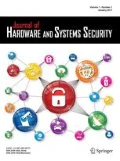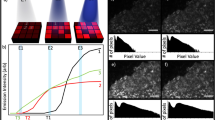Abstract
In this paper, a novel voice-based User-Device (UD-) physical unclonable function (PUF) is demonstrated. In traditional PUFs, variability of challenge-response pairs (CRPs) only comes from physical randomness of silicon. Recently, a new type of PUF, touch screen-based UD-PUF was proposed, which entangles human user biometric variability with the silicon variability. Any silicon-based mobile device sensor which is a UI element can potentially seed such a UD-PUF. Having multiple orthogonal sensor space UD-PUFs helps robustness. If one UD-PUF behaves poorly in certain environmental conditions, another one might behave well. In voice UD-PUF, challenges are single words chosen by the user. The user speaks the challenge word into the microphone of the mobile device. The speech has natural human biometric variability. Raw microphone output data of analog to digital converter (ADC) also reflects the silicon variability. This voice microphone data sequence can be quantized into a binary sequence leading to a PUF—a physical randomness derived, unclonable function. To ensure reproducibility, a background noise reduction algorithm, a statistical error correction, and a frequency domain canonical representation are utilized. Both variability and reproducibility of this voice UD-PUF are evaluated. Several authentication algorithms are proposed in this paper. Pixel-matching authentication algorithm provides an average 15.33% false positive rate and an average 12.30% false negative rate while frame-count authentication algorithm provides an average 6.27% false positive rate and an average 13.23% false negative rate. For variability, we show 250+ bits Hamming distance, on average, between 512 bits binary responses of different (user, device, challenge) combinations. We also assess the pseudorandom number generation properties of voice UD-PUF by putting its binary responses through UMontreal TESTU01 suite of tests. The best voice UD-PUF algorithm passed all 26 randomness tests.

















Similar content being viewed by others
References
Merli D, Sigl G, Eckert C (2013) Identities for embedded systems enabled by physical unclonable functions Number Theory and Cryptography. Springer, pp 125–138
Scheel RA, Tyagi A (2015) Characterizing composite user-device touchscreen physical unclonable functions (pufs) for mobile device authentication Proceedings of the 5th International Workshop on Trustworthy Embedded Devices. ACM, pp 3–13
Flanagan JL, Ishizaka K, Shipley KL (1975) Synthesis of speech from a dynamic model of the vocal cords and vocal tract. Bell Syst Tech J 54(3):485–506
Hendriks R, Erkelens J, Jensen J, Heusdens R (2006) Minimum mean-square error amplitude estimators for speech enhancement under the generalized gamma distribution Proceedings of the International Workshop Acoust Echo Noise Control
Martin R, Altenhöner J (1995) Coupled adaptive filters for acoustic echo control and noise reduction 1995 International Conference on Acoustics, Speech, and Signal Processing, 1995. ICASSP-95, vol 5. IEEE, pp 3043–3046
Diethorn EJ (1997) A subband noise-reduction method for enhancing speech in telephony and teleconferencing 1997 IEEE ASSP Workshop on Applications of Signal Processing to Audio and Acoustics, 1997. IEEE, pp 4–pp
Jensen SH, Hansen PC, Hansen SD, Sørensen JA (1995) Reduction of broad-band noise in speech by truncated qsvd. IEEE Transactions on Speech and Audio Processing 3(6):439–448
Hasan MR, Jamil M, Rahman MGRMS (2004) Speaker identification using mel frequency cepstral coefficients. Variations 1:4
Molau S, Pitz M, Schluter R, Ney H (2001) Computing mel-frequency cepstral coefficients on the power spectrum Proceedings of the 2001 IEEE International Conference on Acoustics, Speech, and Signal Processing, 2001. (ICASSP’01), vol 1. IEEE, pp 73–76
Ahmed N, Natarajan T, Rao KR (1974) Discrete cosine transform. IEEE Trans Comput 100(1):90–93
Soong FK, Rosenberg AE, Juang B-H, Rabiner LR (1987) Report: a vector quantization approach to speaker recognition. AT&T Technical Journal 66(2):14–26
Vasilakis E (2015) An instruction level energy characterization of arm processors, Ph.D. dissertation, Department of Computer Science University of Crete
Lee S, Ermedahl A, Min SL, Chang N (2001) An accurate instruction-level energy consumption model for embedded risc processors. SIGPLAN Not 36(8):1–10. [Online]. Available. doi:10.1145/384196.384201
Azami H, Mohammadi K, Bozorgtabar B (2012) An improved signal segmentation using moving average and savitzky-golay filter. Journal of Signal and Information Processing 3(1):39–44
Standard SH (2002) National institute of standards and technology (nist), fips publication 180-2
L’Ecuyer P, Simard R (2007) Testu01: Ac library for empirical testing of random number generators. ACM Trans Math Softw (TOMS) 33(4):22
Acknowledgments
This project was supported by the Dept. of Homeland Security, Science and Technology Directorate under Contract # D l 5PC00158.
Author information
Authors and Affiliations
Corresponding author
Rights and permissions
About this article
Cite this article
Guo, Y., Tyagi, A. Voice-Based User-Device Physical Unclonable Functions for Mobile Device Authentication. J Hardw Syst Secur 1, 18–37 (2017). https://doi.org/10.1007/s41635-017-0003-4
Received:
Accepted:
Published:
Issue Date:
DOI: https://doi.org/10.1007/s41635-017-0003-4




